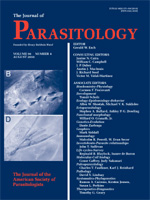Halipegus eccentricus is a common hemiurid trematode in the eustachian tubes of North America frogs. However, the life cycle of this species has never been completely elucidated. Studies on H. eccentricus suggest that it has a 3-host life cycle. Here, we show through fieldwork and host specificity experimental infections that the life cycle of Halipegus eccentricus utilizes 4 hosts. Metamorphosed anurans become infected with H. eccentricus by feeding on infected damselflies; worms reside in the stomach of anurans, migrate to the eustachian tubes within 32–39 days post-exposure (DPE), and release eggs 50–60 DPE. Cystophorous cercariae develop in Physa gyrina snails within 32–35 DPE, infect ostracod (Cypridopsis sp.) second intermediate hosts, and develop to metacercariae. Fifteen- to 19-day-old metacercariae from ostracods are infective to both damselfly larvae and metamorphosed anurans. Field surveys of damselflies and tadpoles, along with laboratory exposure of damselfly larvae, metamorphosed anurans, and tadpoles with infected ostracods, indicated that only metamorphosed anurans and damselflies become infected with H. eccentricus, whereas field-collected tadpoles and laboratory-exposed tadpoles were never infected with H. eccentricus. Because little morphological change occurred in the metacercaria stage of H. eccentricus between the ostracod second intermediate host and damselfly host, and metamorphosed anurans became infected with H. eccentricus metacercariae recovered from both host groups, we suggest that odonates serve as paratenic hosts in this life cycle. Additionally, our field work and experimental infections provide data on the use of odonates as the route of infection by another North American Halipegus sp. that matures in the stomach of frogs. Our data indicate that when the life cycles are known, the use of odonates as the route of infection to anurans is common in the life cycles of Halipegus spp., and all species exhibit remarkable infection site fidelity in their amphibian hosts.
How to translate text using browser tools
1 August 2010
The Role of Damselflies (Odonata: Zygoptera) as Paratenic Hosts in the Transmission of Halipegus eccentricus (Digenea: Hemiuridae) to Anurans
Matthew G. Bolek,
Heather R. Tracy,
John Janovy
ACCESS THE FULL ARTICLE

Journal of Parasitology
Vol. 96 • No. 4
August 2010
Vol. 96 • No. 4
August 2010




